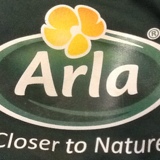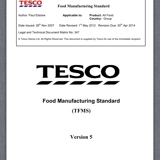Information
-
Document No. 10001
-
Product type
-
Factory
-
Address
-
Attendants
-
Conducted on
-
Prepared by
-
Signature
-
Factory external, Factory entrance images
Factory
Factory organisation
-
Available
-
Organisation Chart Images
-
Production Workflow Chart
-
Export licence issue date
-
Observations and Risk
-
Images
Images environment and ethics
-
Images for - Punch card area, Drinking water areas, Fire exits, Safety guards on machines, PPE used, Electric wiring / box, First aid, Hazardous chemical storage, Accommodation overview
-
Images
Production lines
Goods In
-
All incoming goods assigned with the bath number and any identifying codes assigned by the factory
-
Sample and specification available
-
Frequency of checks by trained staff
-
There must be a record (and test reports where applicable)
-
What are the delivery / loading conditions?
-
Observation and Risk
-
Images
Storage and segregation
-
Components should be stored in racking, well labelled and a system in place for identifying location.<br>
-
Components have an identifying code that relates back to the incoming goods records
-
NC goods and components should be quarantined in clearly labelled areas away from acceptable stock
-
What is done with the non conforming materials?
-
Observation and Risk
-
Images
Production lines
-
Production planning notice board
-
Are the lines in production during visit
-
Product line overview and instructions
-
Is the assembly line tidy and organised?
-
Floor markings around the production area?
-
Walking areas free from obstruction?
-
Tools kept clean, well maintained and replaced where necessary?
-
Observation and Risk
-
Images
Quality Assurance System and Related Certificates
-
Does the management have an understanding of ISO 9001 or similar?
-
Are QC staff fully independent of production staff?
-
Are QC supervisors easily identified?
-
Are the QC staff trained?
-
Does the QC manager have authority to stop production?
-
Does the factory perform regular QC checks at major production stages?
-
Are records available
-
Frequency
-
Online QC and testing stations
-
Are clear instructions visible at all work stations?
-
Observations and Risk
-
Images
Production Documentation
-
Must maintain and be able to demonstrate traceability from final product back to a specific batch of raw materials and associated test reports
-
Correlation of records to labels, batch numbers or marks attached to the furniture
-
Does the factory have equipment and machinery list?
-
Documents for calibrated machines?
-
Records available
-
Frequency
-
All tools must be signed in and out
-
Missing tool procedure?
-
Has the factory had a technical audit
-
Audit company
-
Date
-
Available
-
Observation and Risk
-
Images
Approved samples
-
Approved samples on display at each area with a signature and date from a technical representative
-
Observation and Risk
-
Images
Finished product inspection
-
The checks are made against the specification to ensure product, its components, packaging and labelling is correct
-
Observation and Risk
-
Images
Handling and Packing
-
Packaging stored on pallets in dry indoor location
-
Handling process protects finished or semi finished product from damage
-
No risk of foreign bodies being packed
-
Only safety tools are used during packaging process
-
No staples are used during packing
-
Board showing all approved components
-
Controls in place to ensure correct numbers of components are added to each hardware pack
-
No risk of foreign bodies being packed
-
No staples are used during packing
-
Observation and Risk
-
Images
Metal CCP
Goods In
-
Dimensions - Cross sectional profile including wall thickness
-
Physical properties i.e. Tensile strength, elongation %, yield strength and hardness (being the minimum)
-
Observation and Risk
-
Images
Welding
-
Pre welding - Use of jigs and approved samples to ensure correct components and assembly
-
Correct welding techniques and weld quality
-
Observations and Risk
-
Images
Grinding
-
Prevention of over grinding and weld deteriation
-
Ensure all weld spatter and other sharp edges are removed
-
Observations and Risk
-
Images
Assembly
-
Bent rivets, malformed rivets or joints
-
Observations and Risk
-
Images
Finishing
-
Dustraction to ensure a consistently good quality finish
-
Observation and Risk
-
Images
Checks
-
Specification check to ensure product, its components, packaging and labelling are correct
-
Observations and Risk
-
Images
Metal detection
Sewing Controls
Sewing Needle Controls - New
-
A designated supervisor must be responsible for issuing new needles
-
New needles must be stored in a clearly marked container and in a locked cupboard, one person responsible with key
-
New needles must only be obtained when broken or damaged needles are returned or when there is a change of fabric type
-
Used needles must only be replaced with new needles
-
The exchanged needles must be held in a clearly marked secure container, ready for disposal, in separate location to the secured "new needles" container
-
All used needles must be accounted for
-
Sewing operatives must never have spare needles in their possession
-
Any spare or unused machines in the factory must have all needles removed from them
-
The mechanic must perform daily checks of all machines and any problems relating to needles must be recorded and the needle changed
-
All machines must be equipped with the correct type and functionally required quantity of needles
-
Observations and Risk
-
Images
Sewing Needle Controls - Broken Needles
-
If a needle is broken, all parts must be accounted for before a new needle is issued
-
Isolate all products involved or in the vicinity within a sealed container or bag and remove to be fully detected by the supervisor
-
If all parts of the needle are found and the product detected successfully the product may be returned to stock
-
All parts of a broken needle must be securely attached to a "broken needle record form" by the nominated supervisor along with details of date, machine and operator. The needle parts should be "built" together to clearly highlight any missing fragments
-
If all parts of a needle can't be found then the whole area within the vicinity must be checked with a magnet or a hand held detector
-
If all parts of the broken needle are still not found, then all "at risk" products concerned must be destroyed
-
Following the above, if all parts have still not been located then the issuing of a new needles must be approved by a senior member of staff
-
Replenishment of the authorised needle controllers stock must be on a strict 'new for old' exchange
-
A broken needle control record must be kept for 12 months to facilitate traceability in case of complaint
-
Observations and Risk
-
Images
Hand Sewing Controls
-
Hand sewing can only be used where an automated solution is not feasible
-
For children's products it is only permitted by exception and agreed with Ventura QC
-
Any hand sewing operation on a product must be agreed with Ventura QC manager at the product development stage. Hand sewing on repairs is not permitted
-
An established quantity of hand sewing kits (needle/scissors/clippers etc) must be held by an authorised person
-
Hand sewing equipment must be counted out and in at the end of the shift by a line supervisor along with a maintained record
-
A designated and quarantined area must be established to carry out hand sewing
-
All products hand sewn must be metal detected before release onto the next stage of production
-
Replacement of broken and blunt hand sewing needles must follow the New and Broken Needle Control procedures above
-
Observations and Risk
-
Images
Other Sharp Controls
Pins, Drawing Pins or Staples
-
Pins, drawing pins, metal staples and tacks must not be used in any part of the manufacturing unit, including raw materials warehouse, sample room, cutting, production, knitting and warehousing
-
Where pins are used in packaging for another customer, this must be done in a separate area quarantined from any other production and the issue of pins to be controlled
-
Observations and Risk
-
Images
Scissors and Clippers
-
Scissors, shears or clippers must be secured to workstations to avoid contamination
-
An established quantity of scissors and clippers must be held by an authorised person
-
For "mobile" workers such as QC inspectors, scissors and clippers must be permanently attached/clipped to the worker with an extendable chain. These must be counted in at the end of every shift
-
Observations and Risk
-
Images
Kimball Needles, Tweezers and Cutting Tool Blades
-
Drill holes, spikes, kimball gun needles, notch punchers, tweezers, knives/blades etc must be counted out and in at the end of each shift by a supervisor
-
Observations and Risk
-
Images
Knife Blades
-
Safety knives must be used where blades are required - define tool source
-
No snap blade knives or old straight knives from cutting machines may be used
-
Observations and Risk
-
Images
Carding Machine Hooks, Overlock Machine Blades and Thread Wires
-
Carding hooks, overlock blades and threading wires must be held by the mechanic only and securely stored away from the production area
-
Overlock machine blade must be checked by the operator at the beginning of each shift and any damage reported to the mechanic for immediate repair
-
Spare machine blades must be checked by the operator at the beginning of
-
New blades must be issued as a 'new for old' basis. Where the old blade was broken, all parts must be accounted for before a new blade is issued
-
Old blades must be retained in a secure location
-
Observations and Risk
-
Images
Metal Popper, Studs, Rivets
-
Loose poppers, studs, rivets, zips and other small components must be stored in segregated containers at each work station
-
Observations and Risk
-
Images
Machinery, Equipment and Spare Parts
-
Upon delivery and before release into the production area, all machinery and equipment must be held in a quarantine area to be
-








